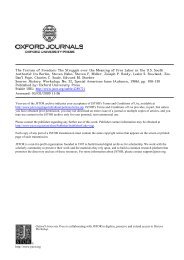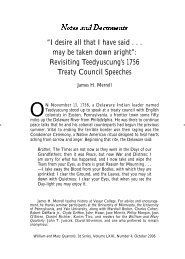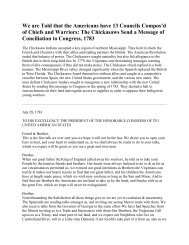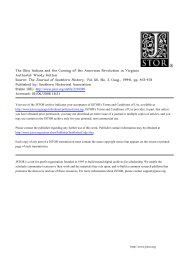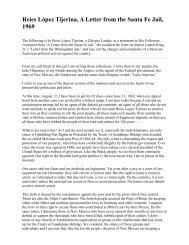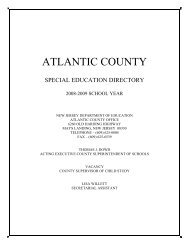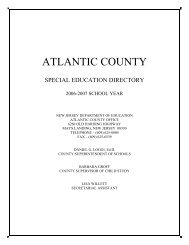A Historical and Regional Overview of Latinas in the United ... - CUNY
A Historical and Regional Overview of Latinas in the United ... - CUNY
A Historical and Regional Overview of Latinas in the United ... - CUNY
Create successful ePaper yourself
Turn your PDF publications into a flip-book with our unique Google optimized e-Paper software.
Introduction: A <strong>Historical</strong> <strong>and</strong> <strong>Regional</strong> <strong>Overview</strong><br />
Rally for community rights, Chelsea, Massachusetts.<br />
Courtesy <strong>of</strong> Aura Sánchez Garfunkel.<br />
not have <strong>the</strong> luxury to choose between work<strong>in</strong>g outside<br />
<strong>the</strong> home <strong>and</strong> be<strong>in</strong>g full-time homemakers. In <strong>the</strong><br />
words <strong>of</strong> Connecticut community builder Genoveva<br />
Rodríguez, “What made me get up <strong>in</strong> <strong>the</strong> morn<strong>in</strong>g; it<br />
wasn’t because I wanted to. It was because I was poor.<br />
And I wanted a better life . . . for my kids. And <strong>the</strong>y<br />
wouldn’t have a better life unless <strong>the</strong>y went to school.”<br />
After World War II Puerto Rican barrios multiplied<br />
throughout <strong>the</strong> Nor<strong>the</strong>ast, <strong>in</strong> great measure because <strong>of</strong><br />
<strong>the</strong> <strong>in</strong>dustrialization policies <strong>of</strong> <strong>the</strong> government <strong>of</strong><br />
Puerto Rico. Migrant populations <strong>in</strong>creased dramatically,<br />
<strong>and</strong> dur<strong>in</strong>g <strong>the</strong> 1950s <strong>and</strong> 1960s an additional<br />
20,000 seasonal contract farm laborers added to <strong>the</strong><br />
migrant numbers. Seasonal workers, recruited to plant<br />
<strong>and</strong> harvest agricultural production, <strong>of</strong>ten rema<strong>in</strong>ed <strong>in</strong><br />
<strong>the</strong> regions <strong>of</strong> <strong>the</strong>ir contractual obligations, sent for<br />
Participants <strong>in</strong> a social club organization, Hotel<br />
Granada, Brooklyn, 1962. Courtesy <strong>of</strong> <strong>the</strong> Justo A.<br />
Martí Photograph Collection. Centro Archives,<br />
Centro de Estudios Puertorriqueños, Hunter College,<br />
<strong>CUNY</strong>.<br />
10<br />
q<br />
<strong>the</strong>ir families, <strong>and</strong> gave rise to sizable communities <strong>in</strong><br />
places like Dover, New Jersey, Hartford <strong>and</strong> Bridgeport,<br />
Connecticut, Lora<strong>in</strong>, Ohio, <strong>and</strong> Chicago, Ill<strong>in</strong>ois. (Until<br />
<strong>the</strong> 1970s, 80 percent <strong>of</strong> <strong>the</strong> migrant flow cont<strong>in</strong>ued to<br />
come <strong>in</strong>to New York City; 860,552 Puerto Ricans<br />
resided <strong>in</strong> New York, but 1.5 million appeared <strong>in</strong> <strong>the</strong><br />
national census <strong>of</strong> that year, with sizable populations<br />
<strong>in</strong> Chicago, Philadelphia, Newark, Hartford, <strong>and</strong> Jersey<br />
City.) Moreover, <strong>the</strong> 1960s witnessed immigration legislation<br />
that elim<strong>in</strong>ated preferences <strong>in</strong> <strong>the</strong> quota system<br />
based on national orig<strong>in</strong>s. Legal reforms encouraged<br />
Western Hemisphere emigration <strong>and</strong> family<br />
reunification <strong>and</strong> opened <strong>the</strong> door to an unprecedented<br />
immigration from <strong>the</strong> Caribbean, Mexico, <strong>and</strong> Central<br />
<strong>and</strong> South America. Economic uncerta<strong>in</strong>ty <strong>and</strong> political<br />
unrest were <strong>the</strong> most powerful factors <strong>in</strong> this immigration.<br />
The result was <strong>the</strong> emergence <strong>of</strong> a highly diverse,<br />
multilayered, ethnoracial Lat<strong>in</strong>o(a) community<br />
that comb<strong>in</strong>ed recent arrivals with longtime residents,<br />
citizens with aliens, <strong>and</strong> Spanish speakers with<br />
second-, third-, or fourth-generation English-dom<strong>in</strong>ant<br />
hyphenated Americans.<br />
For Puerto Rican, Dom<strong>in</strong>ican, Cuban, <strong>and</strong> o<strong>the</strong>r<br />
Lat<strong>in</strong>a women, community issues, such as bil<strong>in</strong>gual<br />
education, access to higher education, health, environment,<br />
employment, <strong>and</strong> adequate liv<strong>in</strong>g conditions,<br />
reigned supreme. Communities mobilized, formed organizations<br />
for advancement, created <strong>the</strong> conditions<br />
for an emergent leadership, <strong>and</strong> combated racism <strong>and</strong><br />
discrim<strong>in</strong>ation. Organizations like ASPIRA, <strong>the</strong> Puerto<br />
Rican Family Institute, <strong>the</strong> Puerto Rican Association for<br />
Community Affairs (PRACA), <strong>and</strong> <strong>the</strong> Puerto Rican<br />
Forum <strong>in</strong> New York spawned counterparts throughout<br />
<strong>the</strong> Nor<strong>the</strong>ast with different names but <strong>the</strong> same <strong>in</strong>tentions.<br />
Indeed, many <strong>of</strong> <strong>the</strong> groups that orig<strong>in</strong>ated<br />
throughout <strong>the</strong> civil rights period had national <strong>and</strong> <strong>in</strong>ternational<br />
connections <strong>and</strong> cont<strong>in</strong>ue to <strong>the</strong> present.<br />
Women were front <strong>and</strong> center <strong>in</strong> many <strong>of</strong> <strong>the</strong>se ventures.<br />
In New York, Pantoja worked alongside a dedicated<br />
group <strong>of</strong> social workers <strong>and</strong> educators that <strong>in</strong>cluded<br />
high-pr<strong>of</strong>ile figures like Joseph<strong>in</strong>e Nieves, Alice



